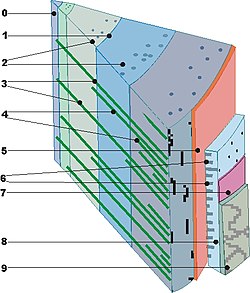Vascular cambium
![]()
This article describes the cambium of woody plants, for the cambium layer of the periosteum see periosteum.
Cambium (Latin cambium = alternation) is the tissue layer that is responsible for thickness growth in plants. In trees, it is the hollow cylindrical growth layer between the sapwood zone and the bark (bast zone and bark), which is also called the cambium ring.
This layer is responsible for secondary shoot growth (thickness growth). It can be called secondary or lateral meristem in contrast to the primary apical meristem. It lies between the xylem (inner) and phloem (outer). In most of the monocotyledonous plants there is no cambium in the vascular bundle (xylem/phloem), which is why they are not capable of secondary thickness growth in the form of the dicotyledonous plants.
In an early developmental stage of a dicotyledonous plant, the cambium is only present as a so-called fascicular cambium and is located within the vascular bundles (lat. fasces). In the course of further development, further meristematic tissue develops from already differentiated cells of the parenchymatic medullary ray tissue at the level of the fascicular cambium - via hormonal influences and remeristematization. This is called interfascicular cambium. Fascicular and interfascicular cambium together form the closed cambium ring of a dicotyledonous plant.
There are monocotyledonous plants, such as palms, that exhibit massive primary thickness growth. However, this occurs through the apical meristem. As a result, the shoot has the near maximum diameter from the beginning. Some monocotyledons exhibit apparent secondary thickness growth through vegetative growth and accumulation of dead leaf sheaths. This occurs, for example, in palm lilies, dragon trees, or elephant foot. Secondary thickness growth requires a closed cambium ring that evenly forms and releases new cells inward and outward along the entire circumference. The pre-existing portion of the cambium ring that lies between the xylem and phloem within the leader bundle is called the fascicular cambium. In order to form a closed cambium ring, the parenchyma cells of the medullary rays are remeristematized by hormonal stimuli and subsequently form a so-called interfascicular cambium.
According to the definition, all tissue that is shed inwards from the cambium is called wood (= secondary xylem) (independent of lignification) and all tissue that is shed outwards is called bast (= secondary phloem). In the bast an additional cambium, the secondary cork cambium (phellogen), can be formed.

Schematic cross section of wood: 0 pith, 1 annual ring boundary, 2 resin canals, 3 primary wood rays, 4 secondary wood rays, 5 cambium, 6 wood rays of bast, 7 cork cambium, 8 bast, 9 bark.
Search within the encyclopedia